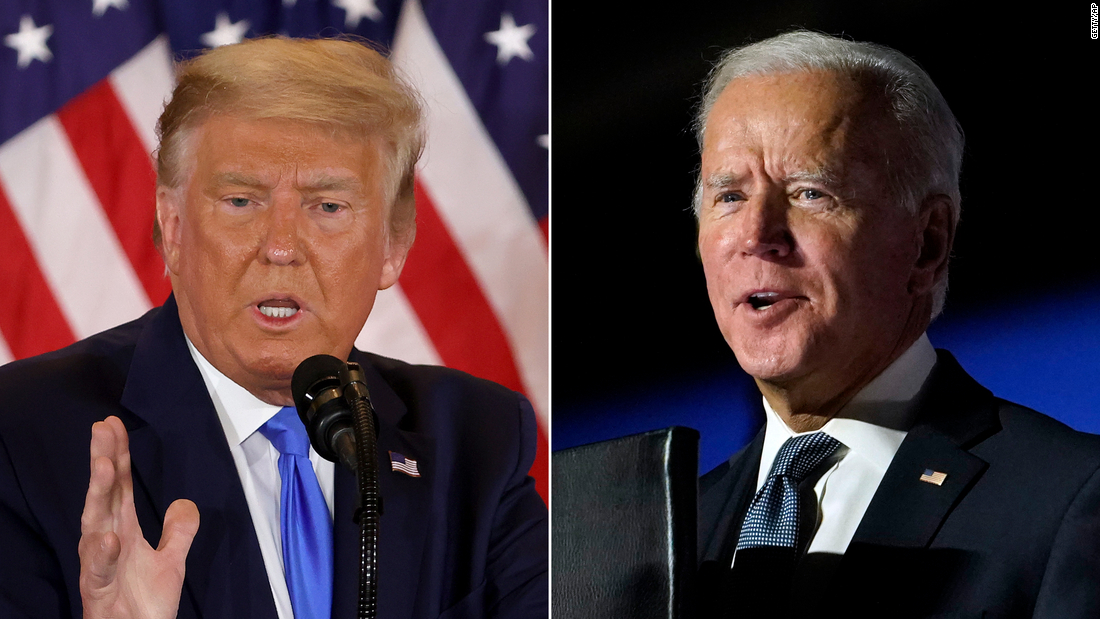
US Elections: Early takeaways from election night | Apadana Media
US Elections News: Several battleground states are still counting votes, and the presidency and control of the Senate remain within either party’s reach.
As of 4 a.m. ET on Wednesday, CNN had not projected winners in Arizona, Georgia, Maine, Michigan, Nevada, North Carolina, Pennsylvania or Wisconsin. Alaska was also too early to call. According to CNN’s projections, Biden has won 224 electoral votes to Trump’s 213.
Huge numbers of mail-in ballots remained uncounted in Democratic strongholds in Georgia, Michigan, Pennsylvania and Wisconsin, where Trump currently leads the vote count.
With many votes left to count, here are five takeaways from the 2020 election so far:
Trump prematurely declared victory
In the wee hours of Wednesday morning, Trump called for legitimate vote-counting to be halted, declaring victory with millions of votes outstanding in several swing states and falsely claiming that Democrats were trying to “steal the election.”
The moment was a chilling threat to democracy. But Trump’s declaration bears no impact on states’ vote counts, with many planning to resume processing absentee ballots later Wednesday morning.
Biden spoke to supporters earlier Wednesday morning in Delaware, telling them that “we believe we’re on track to win this election.”
“Keep the faith guys, we’re going to win this,” Biden said.
Down-ballot Democratic disappointment
Two Democratic Senate challengers, Jaime Harrison in South Carolina and Amy McGrath in Kentucky, raised about $200 million combined to challenge Republican Sens. Lindsey Graham and Mitch McConnell. Both were blown out. Democratic challengers in Iowa and Montana also lost.
Despite record-shattering fundraising numbers across the map, Democrats’ hopes of a net gain of three seats if Biden wins, or four if Trump wins, to give them a Senate majority were slipping. Those hopes could now depend on Georgia, where at least one and potentially two Senate races are headed to runoffs. Results in Maine and North Carolina — two top Democratic targets — remain outstanding.
Many races were left to be decided as of 4 a.m. ET on Wednesday, but Republicans had ousted a few Democratic House members while defending some seats in key districts, potentially shrinking a Democratic majority that was widely expected to grow.
All about Omaha?
Nebraska and Maine divide their electoral votes up by congressional district. While Trump easily won Nebraska overall, he lost the Omaha-based 2nd District — and if Biden reaches 270 electoral votes, that single electoral vote could prove decisive.
As of 4 a.m. ET on Wednesday, Biden led in Arizona, Nevada and Maine (though he trailed in Maine’s 2nd District). If he won those states, he would have 248 electoral votes — 22 shy of 270.
He trails in North Carolina with most of the vote counted there. But Georgia, Michigan, Pennsylvania and Wisconsin all have large numbers of mail-in ballots left to count. If Biden were to win Wisconsin’s 10 electoral votes and 16 more from either Georgia or Michigan, he would reach exactly 270 electoral votes — a path to the presidency that wouldn’t be possible without Nebraska’s 2nd District.
Trumpism is here to stay
The fate of Trump’s re-election bid has not yet been decided. But Tuesday’s results were not the large-scale repudiation that would carry Biden to a landslide victory and force Republicans to re-evaluate their party’s approach.
Democrats’ effort to put three states Trump won handily in 2016 — Iowa, Ohio and Texas — fell flat. Florida continued to flummox the party. Republicans, meanwhile, were on track to pick up House seats, and fended off a number of serious Senate challenges
Georgia and Arizona appear more competitive than they were in 2016, and it’s not yet clear whether Biden has rebuilt the “blue wall” of Wisconsin, Michigan and Pennsylvania. But 2020 did not bring anything close to a remaking of the electoral map.
Democrats struggled with Latinos
For months, Democratic organizers and operatives warned that the party was at risk of a poor performance in Florida’s heavily Cuban Miami-Dade County, and that it hadn’t been reaching nearly enough Latinos in the Rio Grande Valley to turn Texas into a battleground.
Those fears proved to be founded, as Biden fell well short of Hillary Clinton’s 2016 performance in those areas.
Latinos are not a monolith, and the politics of Cubans in Miami, Puerto Ricans in Orlando and Mexicans in South Texas can vary widely. But after falling short of expectations in several key areas — and doing so against a President who has treated immigrants harshly and mismanaged a pandemic that was disproportionately deadly for Latinos — Democrats must now face hard truths about their shrinking margins with a fast-growing segment of the electorate.









